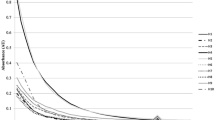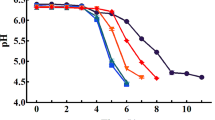Abstract
A study was investigated to determine and compare the key aroma components in raw and roasted walnut (Juglans regia L.). The effective aromatic compounds in raw and roasted walnut were separated by solvent-assisted flavor evaporation (SAFE), and a total of 160 volatile compounds were identified by gas chromatography-mass spectrometry (GC–MS), which constituted the distinctive flavor of raw and roasted walnut. The key aroma components were further revealed by aroma extract dilution analysis (AEDA), and 29 aroma compounds were identified as highly related to the characteristic aroma of walnut. Finally, the selected aroma compounds were quantitated and odor activity values (OAVs) were calculated. A total of 10 aroma-active compounds of OAVs ≥ 1 were identified in raw walnut, among which (E)-2-nonenal showed the highest OAV, and octanal, hexanal, and nonanal were also contributive to the flavor of raw walnut. In roasted walnut, 20 aroma-active compounds (OAVs ≥ 1) were obtained, and (E,E)-2,4-decadienal, 1-octen-3-ol and pyrazines were the characteristic flavor sources of roasted walnut. In general, the roasting process had a significant effect on the flavor characteristics of walnut; it can increase complexities to the walnut volatiles, and provide a more desirable roast and nutty flavor.



Similar content being viewed by others
Availability of Data and Material
The datasets used during the current study are available from the corresponding author on reasonable request.
Code Availability
Not applicable.
References
Amini M, Ghoranneviss M (2016) Effects of cold plasma treatment on antioxidants activity, phenolic contents and shelf life of fresh and dried walnut (Juglans regia L.) cultivars during storage. LWT - Food Science and Technology. https://doi.org/10.1016/j.lwt.2016.06.014
Baba R, Amano Y, Wada Y, Kumazawa K (2017) Characterization of the potent odorants contributing to the characteristic aroma of matcha by gas chromatography-olfactometry techniques. J Agric Food Chem. https://doi.org/10.1021/acs.jafc.7b00421
Baker GL, Cornell JA, Gorbet DW et al (2003) Determination of pyrazine and flavor variations in peanut genotypes during roasting. J Food Sci 68:394–400. https://doi.org/10.1111/j.1365-2621.2003.tb14171.x
Burdack-Freitag A, Schieberle P (2010) Changes in the key odorants of Italian hazelnuts (Corylus avellana L. Var. Tonda Romana) induced by roasting. J Agric Food Chem. https://doi.org/10.1021/jf100692k
Cantalejo MJ (1997) Analysis of volatile components derived from raw and roasted earth-almond (Cyperus esculentus L.). J Agric Food Chem. https://doi.org/10.1021/jf960467m
Chang AS, Sreedharan A, Schneider KR (2013) Peanut and peanut products: a food safety perspective. Food Control
Chetschik I, Granvogl M, Schieberle P (2008) Comparison of the key aroma compounds in organically grown, raw West-African peanuts (Arachis hypogaea) and in ground, pan-roasted meal produced thereof. J Agric Food Chem. https://doi.org/10.1021/jf802102u
Christopoulos MV, Tsantili E (2015) Oil composition in stored walnut cultivars-quality and nutritional value. Eur J Lipid Sci Technol. https://doi.org/10.1002/ejlt.201400082
Clark RG, Nursten HE (1976) Volatile flavour components of walnuts (Juglans regia L.). J Sci Food Agric. https://doi.org/10.1002/jsfa.2740271003
Clark RG, Nursten HE (1977) The sensory analysis and identification of volatiles from walnut (Juglans regia L.) headspace. J Sci Food Agric. https://doi.org/10.1002/jsfa.2740280111
Crowe TD, Crowe TW, Johnson LA, White PJ (2002) Impact of extraction method on yield of lipid oxidation products from oxidized and unoxidized walnuts. J Am Oil Chem Soc. https://doi.org/10.1007/s11746-002-0505-7
Di Cagno R, Filannino P, Gobbetti M (2017) Lactic acid fermentation drives the optimal volatile flavor-aroma profile of pomegranate juice. Int J Food Microbiol. https://doi.org/10.1016/j.ijfoodmicro.2017.02.014
Engel W, Bahr W, Schieberle P (1999) Solvent assisted flavour evaporation - a new and versatile technique for the careful and direct isolation of aroma compounds from complex food matrices. Eur Food Res Technol. https://doi.org/10.1007/s002170050486
Erten ES, Cadwallader KR (2017) Identification of predominant aroma components of raw, dry roasted and oil roasted almonds. Food Chem. https://doi.org/10.1016/j.foodchem.2016.08.091
Guasch-Ferré M, Liu X, Malik VS et al (2017) Nut consumption and risk of cardiovascular disease. J Am Coll Cardiol. https://doi.org/10.1016/j.jacc.2017.09.035
Guo X, Song C, Ho CT, Wan X (2018) Contribution of L-theanine to the formation of 2,5-dimethylpyrazine, a key roasted peanutty flavor in Oolong tea during manufacturing processes. Food Chem. https://doi.org/10.1016/j.foodchem.2018.04.117
He F, Qian YPL, Qian MC (2018) Flavor and chiral stability of lemon-flavored hard tea during storage. Food Chem. https://doi.org/10.1016/j.foodchem.2017.06.136
Ho CT, Zheng X, Li S (2015) Tea aroma formation. Food Sci Human Wellness. https://doi.org/10.1016/j.fshw.2015.04.001
Jahanbani R, Ghaffari SM, Salami M et al (2016) Antioxidant and anticancer activities of walnut (Juglans regia L) protein hydrolysates using different proteases. Plant Foods Hum Nutr. https://doi.org/10.1007/s11130-016-0576-z
Kelebek H, Kesen S, Sonmezdag AS et al (2018) Characterization of the key aroma compounds in tomato pastes as affected by hot and cold break process. J Food Meas Charact. https://doi.org/10.1007/s11694-018-9863-8
Kesen S, Amanpour A, Selli S (2018) Comparative evaluation of the fatty acids and aroma compounds in selected Iranian nut oils. Eur J Lipid Sci Technol. https://doi.org/10.1002/ejlt.201800152
Lau H, Liu SQ, Xu YQ et al (2018) Characterising volatiles in tea (Camellia sinensis). Part I: Comparison of headspace-solid phase microextraction and solvent assisted flavour evaporation. LWT. https://doi.org/10.1016/j.lwt.2018.04.058
Liu H, Wang Z, Zhang D et al (2019) Characterization of key aroma compounds in Beijing roasted duck by gas chromatography-olfactometry-mass spectrometry, odor-activity values, and aroma-recombination experiments. J Agric Food Chem. https://doi.org/10.1021/acs.jafc.9b01564
Martínez M, Barrionuevo G, Nepote V et al (2011) Sensory characterisation and oxidative stability of walnut oil. Int J Food Sci Technol. https://doi.org/10.1111/j.1365-2621.2011.02618.x
Miller AE, Chambers DH (2013) Descriptive analysis of flavor characteristics for black walnut cultivars. J Food Sci. https://doi.org/10.1111/1750-3841.12127
Moreira RFA, Trugo LC, Pietroluongo M, De Maria CAB (2002) Flavor composition of cashew (Anacardium occidentale) and marmeleiro (Croton species) honeys. J Agric Food Chem. https://doi.org/10.1021/jf020464b
Prasad RBN (2003) Walnuts and pecans. In: Caballero B (ed) Encyclopedia of food sciences and nutrition, 2nd edn. Academic Press, Oxford, pp 6071–6079
Ros E (2015) Nuts and CVD. Br J Nutr 113:S111–S120. https://doi.org/10.1017/S0007114514003924
Roscher R, Schwab W, Schreier P (1997) Stability of naturally occurring 2,5-dimethyl-4-hydroxy-3[2H]-furanone derivatives. Eur Food Res Technol
Sasaki T, Koshi E, Take H et al (2017) Characterisation of odorants in roasted stem tea using gas chromatography–mass spectrometry and gas chromatography-olfactometry analysis. Food Chem. https://doi.org/10.1016/j.foodchem.2016.09.208
Schieberle P (1990) The role of free amino acids present in yeast as precursors of the odorants 2-acetyl-1-pyrroline and 2-acetyltetrahydropyridine in wheat bread crust. Z Lebensm Unters Forsch. https://doi.org/10.1007/BF01197621
Selli S, Rannou C, Prost C et al (2006) Characterization of aroma-active compounds in rainbow trout (Oncorhynchus mykiss) eliciting an off-odor. J Agric Food Chem. https://doi.org/10.1021/jf0619582
Senyuva HZ, Gökmen V (2007) Potential of furan formation in hazelnuts during heat treatment. Food Addit Contam
Tapsell LC, Lonergan M, Batterham MJ et al (2017) Effect of interdisciplinary care on weight loss: a randomised controlled trial. BMJ Open. https://doi.org/10.1136/bmjopen-2016-014533
van Gemert LJ (2011) Odour thresholds. Compilations of odour threshold values in air, water and other media, second enlarged and revised ed. Oliemans Punter & Partners BV, Netherlands
Yamanishi T, Shimojo S, Ukita M et al (1973) Aroma of roasted green tea (hoji-cha). Agric Biol Chem. https://doi.org/10.1271/bbb1961.37.2147
Zhang H, Pu D, Sun B et al (2018) Characterization and comparison of key aroma compounds in raw and dry porcini mushroom (Boletus edulis) by aroma extract dilution analysis, quantitation and aroma recombination experiments. Food Chem. https://doi.org/10.1016/j.foodchem.2018.03.056
Zhang L, Wu S, Jin X (2021) Fatty acid stable carbon isotope ratios combined with oxidation kinetics for characterization and authentication of walnut oils. J Agric Food Chem. https://doi.org/10.1021/acs.jafc.1c01843
Zhou Y, Fan W, Chu F, Pei D (2016) Improvement of the flavor and oxidative stability of walnut oil by microwave pretreatment. J Am Oil Chem Soc. https://doi.org/10.1007/s11746-016-2891-9
Acknowledgements
We are greatly thankful to our preceptors N Zhang, B-G Sun and H-T Chen for their contributions to this work. We also thank the staff of Beijing Key Laboratory of Flavor Chemistry for their technical assistance during the course of this work.
Funding
This work was financially supported by the National Natural Science Foundation of China (No. 31901620) and the National Key Technology R & D Program (No. 2018YFD0400600).
Author information
Authors and Affiliations
Contributions
B Liu designed the experiments and collected the data with the help of Y Chang, X-P Sui, R-F Wang, and Z-X Liu. All the authors participated in the analysis and interpretation of the data. B Liu wrote the manuscript draft and revised it according to the feedback of J Sun, H-T Chen, B-G Sun, N Zhang, and J-X Xia. All authors have read and agreed to the published version of the manuscript.
Corresponding author
Ethics declarations
Ethics Approval
This article does not contain any studies with human participants or animals performed by any of the authors.
Consent to Participate
Not applicable.
Consent for Publication
Not applicable.
Conflict of Interest
Bing Liu declares that he has no conflict of interest.
Yuan Chang declares that she has no conflict of interest.
Xinping Sui declares that she has no conflict of interest.
Ruifang Wang declares that she has no conflict of interest.
Zixuan Liu declares that she has no conflict of interest.
Jie Sun declares that she has no conflict of interest.
Haitao Chen declares that he has no conflict of interest.
Baoguo Sun declares that he has no conflict of interest.
Ning Zhang declares that she has no conflict of interest.
Junxia Xia declares that she has no conflict of interest.
Additional information
Publisher’s Note
Springer Nature remains neutral with regard to jurisdictional claims in published maps and institutional affiliations.
Rights and permissions
About this article
Cite this article
Liu, B., Chang, Y., Sui, X. et al. Characterization of Predominant Aroma Components in Raw and Roasted Walnut (Juglans regia L.). Food Anal. Methods 15, 717–727 (2022). https://doi.org/10.1007/s12161-021-02153-7
Received:
Accepted:
Published:
Issue Date:
DOI: https://doi.org/10.1007/s12161-021-02153-7




